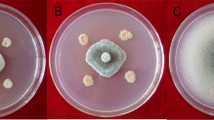Abstract
Orange juice is a major agricultural product, and oranges are among the most widely sold fresh fruits in several countries. Citrus black spot (CBS), caused by the fungus Phyllosticta citricarpa, affects almost every species of citrus, causing a esthetic depreciation of the fruit and fruit drop, with consequent financial loss for its in natura commercialization. Fungicides are the major control measure for CBS, but have limited efficiency and high cost, and give rise to fungal strains resistant to these products. This work assayed the production of antifungal compounds by Bacillus spp. isolates and tested the potential of two isolates from B. subtilis (ACB-AP3 and ACB-83) for controlling CBS under field conditions with two previously untested orange varieties. A total of 15 isolates produced cell-free, thermostable or volatile compounds effective in suppressing P. citricarpa growth in vitro. It was possible to detect the production of two antibiotics (iturin and surfactin) by B. subtilis ACB-83. Additionally, B. subtilis isolates ACB-AP3 and ACB-83 displayed significant effects in controlling the disease under field conditions.






Similar content being viewed by others
References
Asari S, Matzén S, Petersen MA, Bejai S, Meijer J (2016) Multiple effects of Bacillus amyloliquefaciens volatile compounds: plant growth promotion and growth inhibition of phytopathogens. FEMS Microbiol Ecol 92: fiw 070
Bais HP, Fall R, Vivanco JM (2004) Biocontrol of Bacillus subtilis against infection of Arabidopsis roots by Pseudomonas syringae is facilitated by biofilm formation and surfactin production. Plant Physiol 134:307–319
Bernardo ERA, Bettiol W (2010) Controle da pinta preta dos frutos cítricos em cultivo orgânico com agentes de biocontrole e produtos alternativos. Trop Plant Pathol 35:037–042
Dennis CE, Webster J (1971) Antagonistic properties of species groups of Trichoderma III. Hyphal interactions. Trans Brit Mycol Soc 57:359–363
Fagan C (1999) Efeito da mancha preta dos frutos cítricos, causada por Guignardia citricarpa, nas características tecnológicas do suco de frutos de laranja ‘Natal’ e ‘Valência’. Trabalho de Graduação, FCAV/UNESP, Jaboticabal, São Paulo, p 43p
Feichtenberger E, Bassanezi RB, Sposito MB, Belasque Jr J (2005) Doenças dos Citros. In: Kimati H, Amorim L, Resende JAM, Bergamin Filho A, Camargo LEA (eds). Manual de Fitopatologia, v.2. Editora Ceres, São Paulo, pp 239–269
Ferraz LP, da Cunha T, da Silva AC, Kupper KC (2016) Biocontrol ability and putative mode of action of yeasts against Geotrichum citri-aurantii in citrus fruit. Microbiol Res 188:72–79
Fialho MB, Toffano L, Pedroso MP, Augusto F, Pascholati S (2010) Volatile organic compounds produced by Saccharomyces cerevisiae inhibit the in vitro development of Guignardia citricarpa, the causal agent of citrus black spot. World J Microbiol and Biotechnol 26:925–932
Fundecitrus (2017) Doenças e Pragas: Pinta Preta. Araraquara
Goes A, Andrade AG, Moretto KCK (2000) Efeito de diferentes tipos de óleos na mistura de benomyl + mancozeb no controle de Guignardia citricarpa, agente causal da mancha preta dos frutos cítricos. Summa Phytopathol. 26:233–236
Hong P, Hao W, Luo J, Chen S, Hu M, Zhong G (2014) Combination of hot water, Bacillus amyloliquefaciens HF-01 and sodium bicarbonate treatments to control postharvest decay of mandarin fruit. Postharvest Biol Technol 88:96–102
Kim PII, Ryu J, Kim YH, Chi YT (2010) Production of biosurfactant lipopeptides Iturin A, Fengycin, and Surfactin A from Bacillus subtilis CMB32 for control of Colletotrichum gloeosporioides. J Microbiol and Biotechnol 20:138–145
Klein MN, Silva AC, Kupper KC (2016) Bacillus subtilis based-formulation for the control of postbloom fruit drop of citrus. World J Microbiol Biotechnol 32:205
Kupper KC, Bellotte JAM, Goes A (2009) Controle alternativo de Colletotrichum acutatum, agente causal da queda prematura dos frutos cítricos. Rev Bras Frutic 31:1004–1015
Kupper KC, Corrêa EB, Moretto C, Bettiol W, Goes A (2011) Control of Guignardia citricarpa by Bacillus subtilis and Trichoderma spp. Rev Bras Frutic 33:1111–1118
Kupper KC, Corrêa FE, Azevedo FA, Silva AC (2012) Bacillus subtilis to biological control of postbloom fruit drop caused by Colletotrichum acutatum under field conditions. Sci Hortic 134:139–143
Kupper KC, Cervantes ALL, Klein MN, Silva AC (2013) Avaliação de microrganismos antagônicos, Saccharomyces cerevisiae e Bacillus subtilis para o controle de Penicillium digitatum. Rev Bras Frutic 35:425–436
Leelasuphakul W, Hemmaneea P, Chuenchitt S (2008) Growth inhibitory properties of Bacillus subtilis strains and their metabolites against the green mold pathogen (Penicillium digitatum Sacc.) of citrus fruit. Postharvest Biol Technol 48:113–121
Li Z, Guo B, Wan K, Cong M, Huang H, Ge Y (2015) Effects of bacteria-free filtrate from Bacillus megaterium strain L2 on the mycelium growth and spore germination of Alternaria alternata. Biotechnol & Biotechnol Equip 29:1062–1068
Ministério da Agricultura, Pecuária e Abastecimento (MAPA). (2016) Política Agrícola, Arquivos de Estatísticas: Laranja. Brasília-DF. (Informativo Econômico).
Mizumoto S, Hirai M, Shoda M (2006) Production of lipopeptide antibiotic iturin A using soybean curd residue cultivated with Bacillus subtilis in solid-state fermentation. Appl Microbiol Biotechnol 72:869–875
Raaijmakers JM, Vlami M, Souza J (2002) Antibiotic production by bacterial biocontrol agents. Ant van Leeuwenhoek 81:537–547
Stein T (2005) Bacillus subtilis antibiotics: structures, syntheses and specific functions. Mol Microbiol 56:845–857
Souto GI, Correa OS, Montecchia MS, Kerber NL, Pucheu NL, Bachur M, Garcia AF (2004) Genetic and functional characterization of a Bacillus sp. strain excreting surfactin and antifungal metabolites partially identified as iturin-like compounds. J Appl Microbiol 97:1247–1256
Thimon L, Peypoux F, Maget-Dana R, Michel G (1992) Surface-active properties of antifungal lipopeptides produced by Bacillus subtilis. J Am Oil Chem Soc 69:92–93
Acknowledgements
The financial support of the Fapesp (The State of São Paulo Research Foundation) (Proceeding nº 2008/56390–3), is gratefully acknowledged.
Author information
Authors and Affiliations
Corresponding author
Additional information
Publisher's Note
Springer Nature remains neutral with regard to jurisdictional claims in published maps and institutional affiliations.
Rights and permissions
About this article
Cite this article
Kupper, K.C., Moretto, R.K. & Fujimoto, A. Production of antifungal compounds by Bacillus spp. isolates and its capacity for controlling citrus black spot under field conditions. World J Microbiol Biotechnol 36, 7 (2020). https://doi.org/10.1007/s11274-019-2772-0
Received:
Accepted:
Published:
DOI: https://doi.org/10.1007/s11274-019-2772-0




